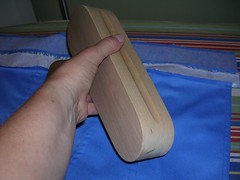
Here's what a clapper looks like. It's a nice hardwood of some kind and very smooth. It doesn't weigh that much - less than an iron anyway. I have seen other conformations in photos but never used any one other than this one.
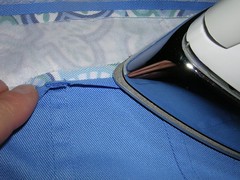
The only "trick" to a clapper is in when you use it. First you press the area that you want to be really flat. I am using the blue jacket I currently still have not finished as the demo. Make sure your iron is warm enough for the fabric and preferably using steam. There could be some delicate fabrics that won't take much heat or any steam but I'm not sure you'd want to use a clapper on them anyway.
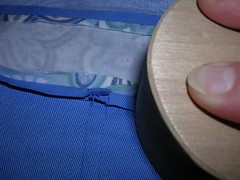
As soon as you remove the iron from the pressed fabric, place the clapper on the hot fabric and press. You can rub the clapper along the fabric or pat it, or, if the fabric is heavy cotton, pound it. The idea is to get the clapper to absorb the heat and steam and sort of force it back into the fabric. I'm not sure exactly how it works, but you do end up with really flat fabric after using the clapper.
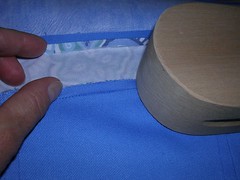
This demo uses the jean jacket because of all the bands and things on it. On the bottom band, I sew the patterned fabric (the inside of the band) to the WRONG side of the jacket. Then I fold it up and attach the folded edge to the OUTSIDE or right side of the jacket. In order to make the seams flat, I first press them open, regardless of whether they will stay open. In this photo, I am pressing both seam allowances into the band area, after I have pressed them open.
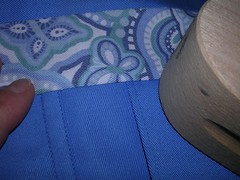
Then I turn the garment over and press the seam on the finished side (which in this spot is the WRONG side of the jacket body). This is effectively the third time I have pressed this seam. Since it will be the final press in this spot before I do the top stitching, I also use the clapper.
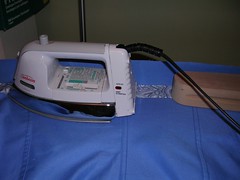
As I go along pressing a seam, I make a little train out of the iron and the clapper, first pressing with heat and steam and following with the clapper to make it good and flat. With this twill fabric, I just run the clapper along the seam. But if I get to areas that won't stay flat, I won't hesitate to pound on them with the clapper.
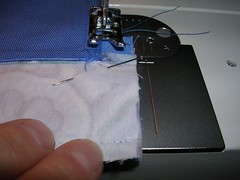
Then I make the bottom band ends by sewing right sides together, folding the band along the seam where I have joined the print to the plain fabric.
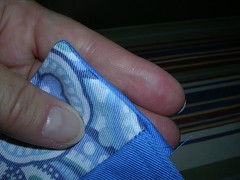
Once I turn the corner right side out and poke the point of the corner out with a point turner, I can iron the end flat too. In this photo, I have not ironed it yet.
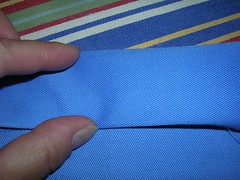
Finally, I have to see how much seam allowance I have to turn under, when I get ready to sew the folded edge of the band to the jacket with topstitching, on the RIGHT side of the jacket body.
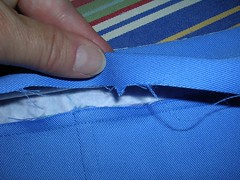
First I fold the seam allowance under so it just covers the stitching line where I first attached the band. Then I pull it away to see that I DO have about 5/8ths of an inch and so I will trim about half of that away before I pin the fold down and topstitch it.
6 comments:
wow, that's really neat!
thank you ... That's a very handy gadget to have ... will have to look around for one.
k
You're welcome! I can't live without it now that I have one.
I've never heard of a "clapper." Sounds like a nice idea :-)
Howtome, the clapper is one of those things that, once you start to use it, you wonder how you did without it all those years. I got mine at a higher end fabric store.
Thanks for the info. That was nice of you :-)
Post a Comment